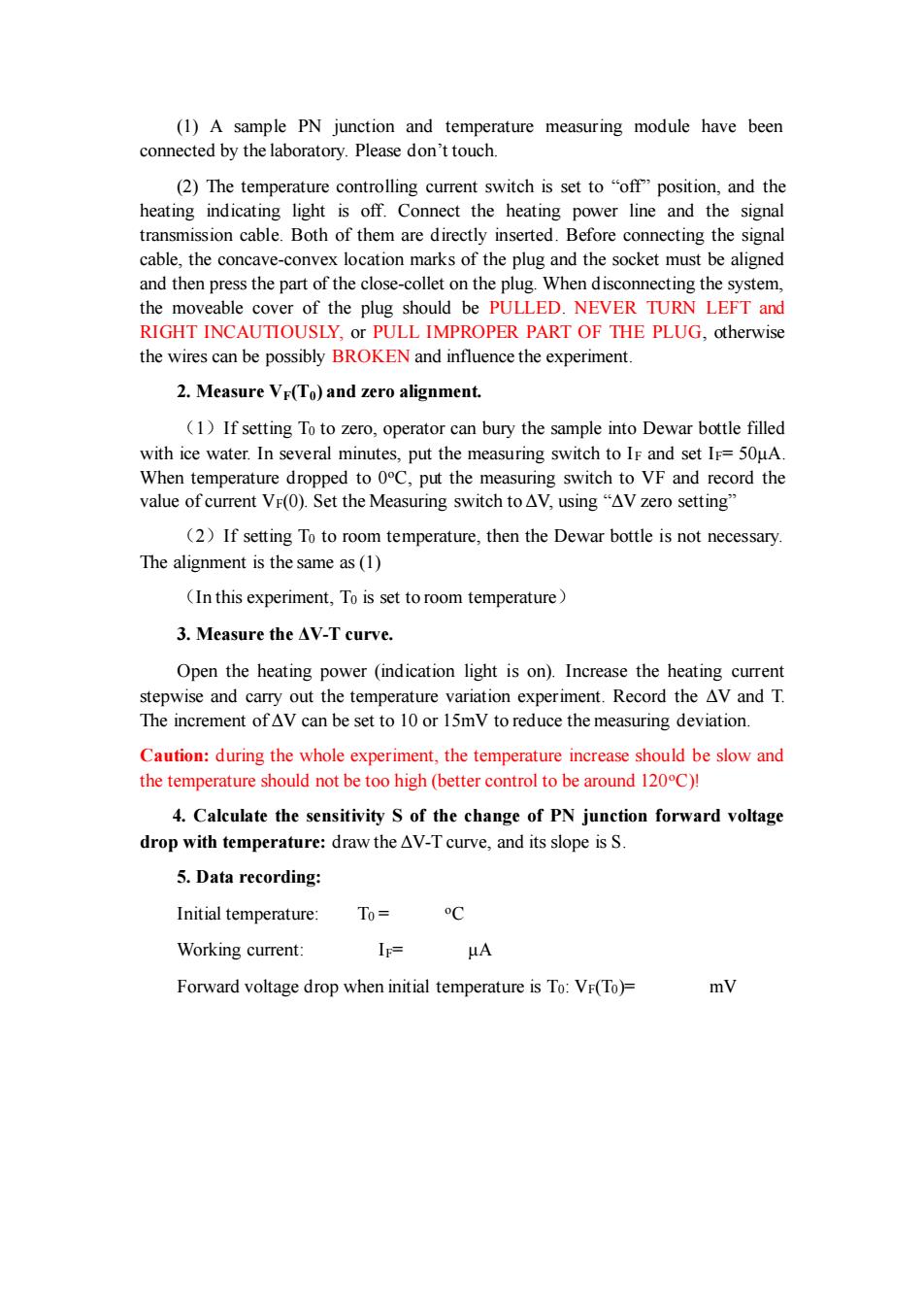正在加载图片...

(1)A sample PN junction and temperature measuring module have been connected by the laboratory.Please don't touch. (2)The temperature controlling current switch is set to "off position,and the heating indicating light is off.Connect the heating power line and the signal transmission cable.Both of them are directly inserted.Before connecting the signal cable,the concave-convex location marks of the plug and the socket must be aligned and then press the part of the close-collet on the plug.When disconnecting the system, the moveable cover of the plug should be PULLED.NEVER TURN LEFT and RIGHT INCAUTIOUSLY,or PULL IMPROPER PART OF THE PLUG,otherwise the wires can be possibly BROKEN and influence the experiment. 2.Measure Vr(To)and zero alignment. (1)If setting To to zero,operator can bury the sample into Dewar bottle filled with ice water.In several minutes,put the measuring switch to IF and set IF=50uA. When temperature dropped to 0C,put the measuring switch to VF and record the value of current VF(0).Set the Measuring switch to AV,using "AV zero setting" (2)If setting To to room temperature,then the Dewar bottle is not necessary. The alignment is the same as(1) (In this experiment,To is set to room temperature) 3.Measure the AV-T curve. Open the heating power (indication light is on).Increase the heating current stepwise and carry out the temperature variation experiment.Record the AV and T. The increment of AV can be set to 10 or 15mV to reduce the measuring deviation. Caution:during the whole experiment,the temperature increase should be slow and the temperature should not be too high(better control to be around 120C)! 4.Calculate the sensitivity S of the change of PN junction forward voltage drop with temperature:draw the AV-T curve,and its slope is S. 5.Data recording: Initial temperature: T0= C Working current: IF= uA Forward voltage drop when initial temperature is To:VF(To)= mV(1) A sample PN junction and temperature measuring module have been connected by the laboratory. Please don’t touch. (2) The temperature controlling current switch is set to “off” position, and the heating indicating light is off. Connect the heating power line and the signal transmission cable. Both of them are directly inserted. Before connecting the signal cable, the concave-convex location marks of the plug and the socket must be aligned and then press the part of the close-collet on the plug. When disconnecting the system, the moveable cover of the plug should be PULLED. NEVER TURN LEFT and RIGHT INCAUTIOUSLY, or PULL IMPROPER PART OF THE PLUG, otherwise the wires can be possibly BROKEN and influence the experiment. 2. Measure VF(T0) and zero alignment. (1)If setting T0 to zero, operator can bury the sample into Dewar bottle filled with ice water. In several minutes, put the measuring switch to I F and set IF= 50μA. When temperature dropped to 0oC, put the measuring switch to VF and record the value of current VF(0). Set the Measuring switch to ΔV, using “ΔV zero setting” (2)If setting T0 to room temperature, then the Dewar bottle is not necessary. The alignment is the same as (1) (In this experiment, T0 is set to room temperature) 3. Measure the ΔV-T curve. Open the heating power (indication light is on). Increase the heating current stepwise and carry out the temperature variation experiment. Record the ΔV and T. The increment of ΔV can be set to 10 or 15mV to reduce the measuring deviation. Caution: during the whole experiment, the temperature increase should be slow and the temperature should not be too high (better control to be around 120oC)! 4. Calculate the sensitivity S of the change of PN junction forward voltage drop with temperature: draw the ΔV-T curve, and its slope is S. 5. Data recording: Initial temperature: T0 = oC Working current: IF= μA Forward voltage drop when initial temperature is T0: VF(T0)= mV